

Damion Smy
Ford Ranger-sized EV ute must prove itself in US before global rollout
13 Hours Ago
You pay a pretty penny for the Ram 1500, but you get a vehicle that's so much more spacious, luxurious and effortless than a 'regular' ute.

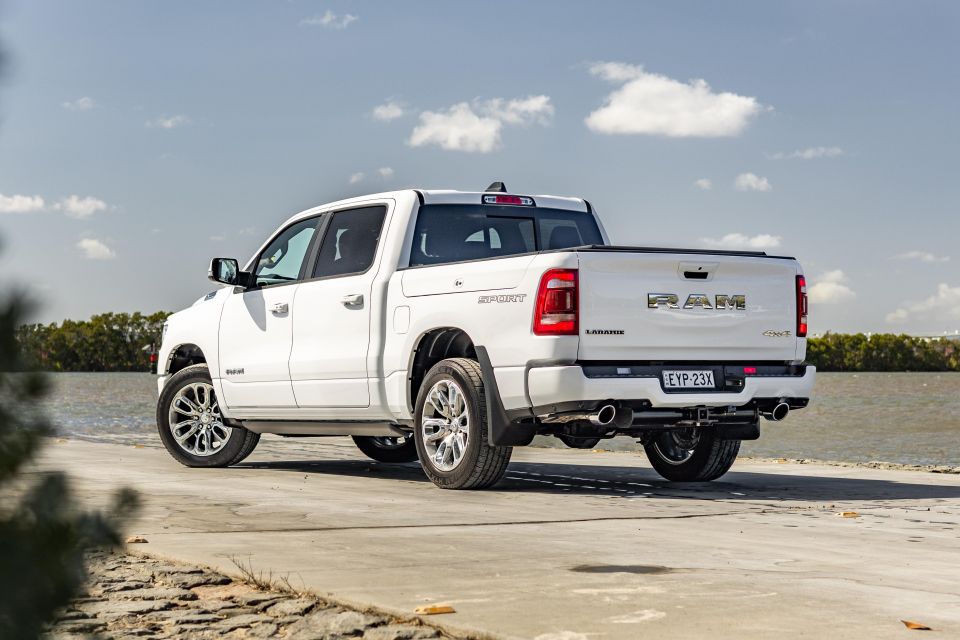

Quickly see how this car stacks up against its competition. Select any benchmark to see more details.
Where expert car reviews meet expert car buying – CarExpert gives you trusted advice, personalised service and real savings on your next new car.
There were Australian outfits that converted left-hand drive pickup trucks to right-hand drive before Ram Trucks Australia hit the scene, but it was this factory-backed operation that really brought this style of vehicle back into the mainstream here.

With Ram’s parent (now Stellantis) building and shipping the vehicles, Walkinshaw managing the remanufacturing process, and Ateco the distribution, buyers were able to have more confidence in their vehicle.
Sales promptly took off, and now the company is looking pretty smart as the brand continues to grow and more and more rivals are entering the fray. When you force Ford and Toyota to follow you, you’re probably onto something good.
TheRam 1500 will soon be joined on the market by the Ford F-150 and Toyota Tundra, not to mention the Chevrolet Silverado that’s already here, even as Ram continues to flesh out the current DT-series range.
The Laramie Sport was introduced back in July, and was quickly followed by the Big Horn.
Whereas the latter is a new entry point to the DT-series range, the Laramie Sport – which Ram calls an MY23 vehicle – slots in between the Laramie and Limited.
American brands love to slather their pickup trucks with chrome, and the Laramie has almost as much chrome as a semi-trailer. The Laramie Sport goes for a more monochromatic look – though there are still polished wheels. Old habits, etc.
White isn’t its best colour – it arguably isn’t for most cars – but in black the Laramie Sport looks properly mean.
The DT-series range is priced from $119,950 to $156,950 before on-road costs, setting aside the TRX that is being retired globally.
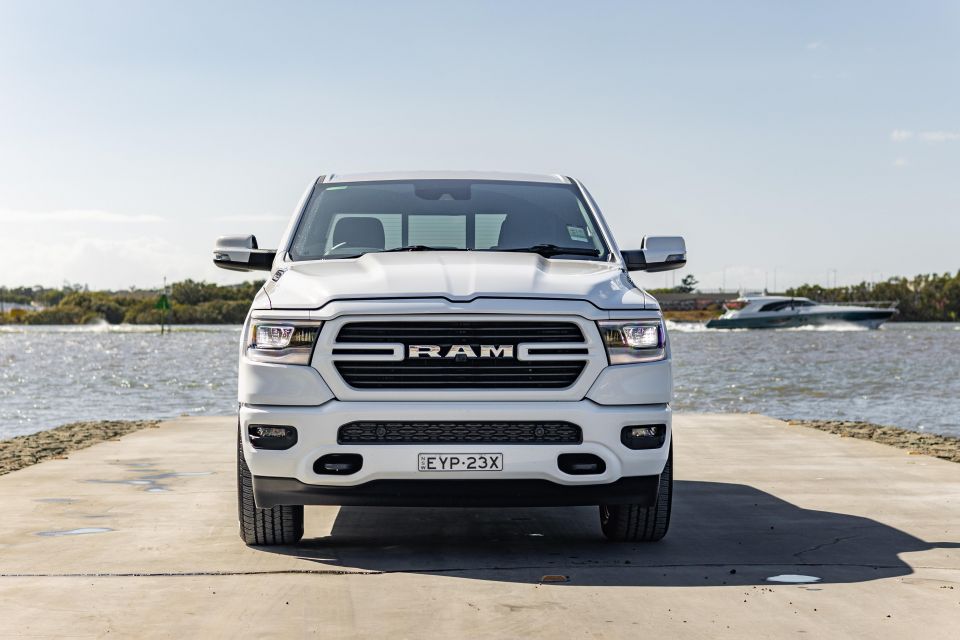
The Laramie Sport is priced at $136,950 before on-roads, or $9000 more than a Laramie. You’re getting quite a bit more than a monochromatic appearance package for that extra outlay, however. More on that later.
It’s priced right up against the Ford F-150 Lariat, which rings up at $139,950 before on-roads in SWB guise and $140,945 in LWB guise, but is undercut by the Chevrolet Silverado 1500 LTZ Premium at $128,000 before on-roads.
Buy your new car without the stress. It's fast, simple and completely free.

Great service from Travis and team, second time I have used this business would not hesitate to recommend them to anyone
Craig C.
Purchased a Ford Ranger in Sunshine Coast, QLD
CarExpert helped Craig save thousands on his Ford Ranger, now let us save you on your next new car.
Find a dealThere’s a premium feel to the Laramie Sport’s interior, with the doors, seats and dashboard swathed in soft leather, leatherette and suede trim, featuring prominent stitching elements, and with soft ambient lighting bathing the cabin. It puts Thai-built utes to shame, but as well it should given its price tag.
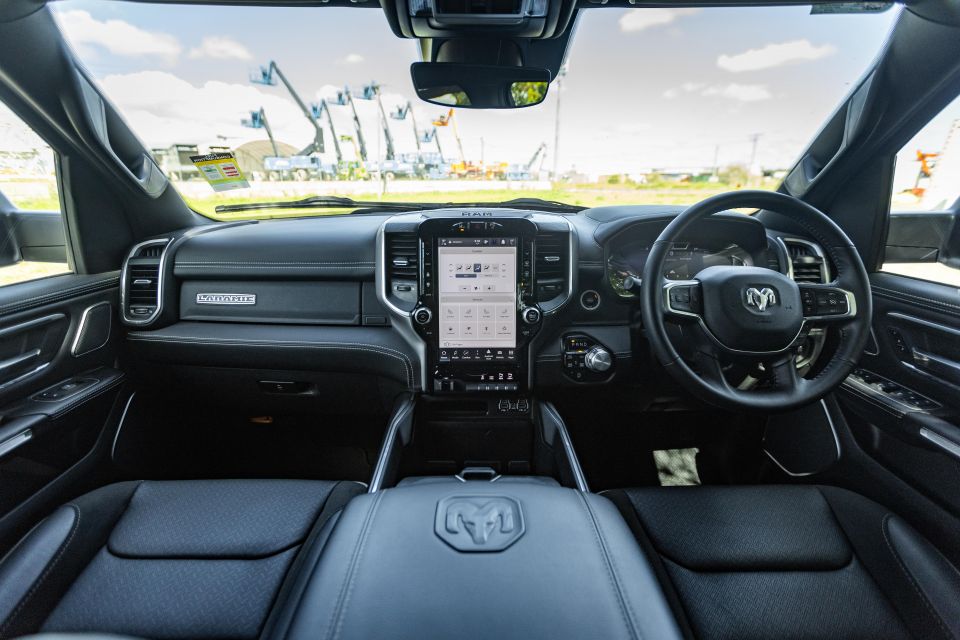
Some of the finishes are a bit odd, like the faux metal-look trim on the dash and the speckly metal trim atop the centre stack. There’s also some piano black trim, though it has been applied sparingly, while there’s a mix of smoother and more traditionally grained leather.
There are a handful of hard, scratchy plastic trim pieces, such as the second glove compartment, and there’s no padding on the sides of the centre console. Additionally, the lower glove compartment has a handle that feels like you could eventually snap off with wear, and it has a flimsy lid and not much space inside.
But even at the Laramie Sport’s $130,000+ price tag, these are only minor gripes. Glove compartment handle aside, there was nothing that stood out as a build or material quality gaffe, and we observed no squeaks or rattles in the interior, apart from the steering – more on that later.
The rotary dial transmission shifter in particular is solid and tactile, as is the chunky, leather-wrapped steering wheel.
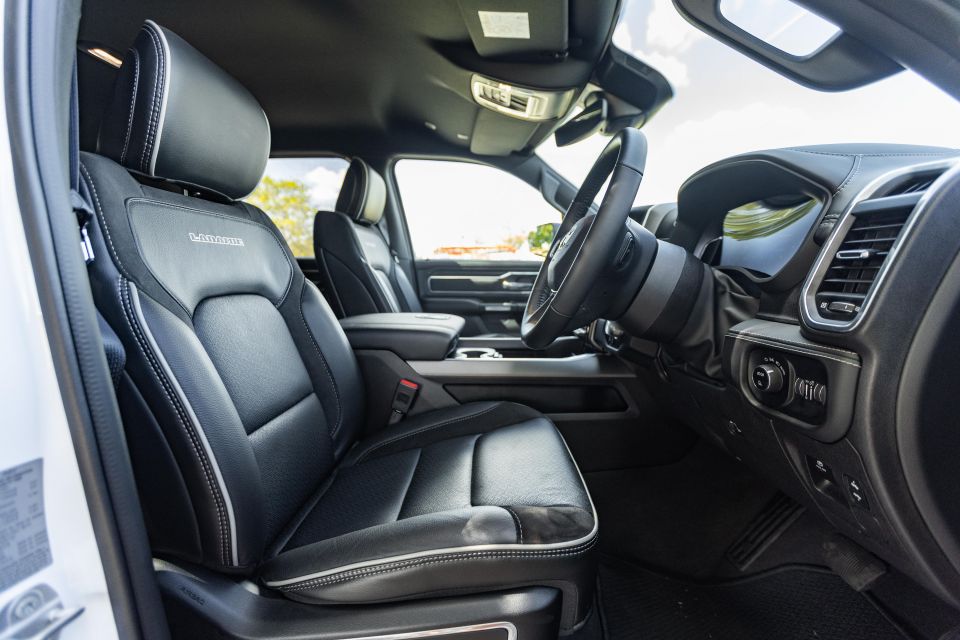

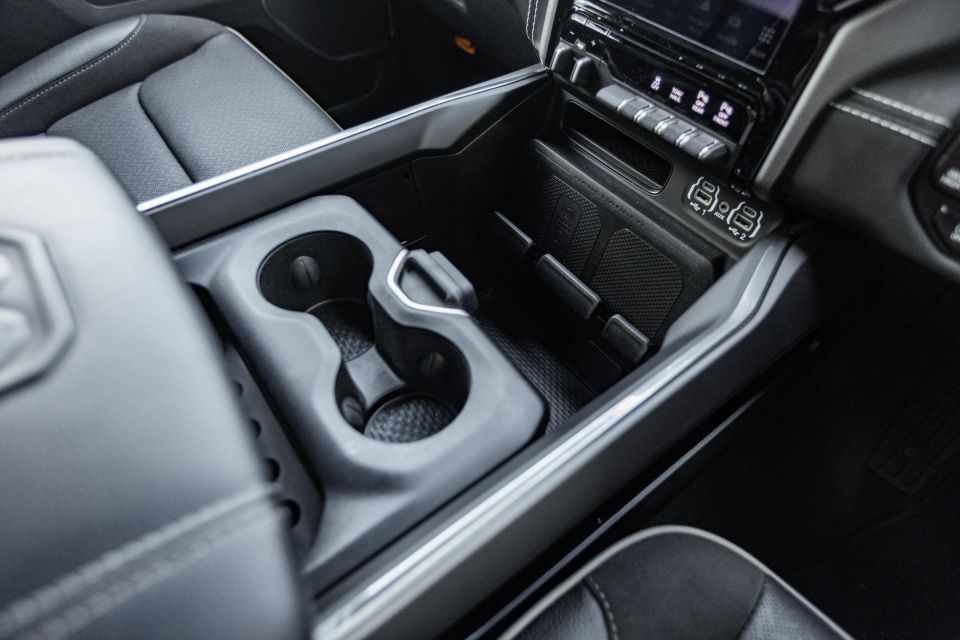

There’s an abundance of storage space up front, including bottle holders in the doors that can easily swallow large bottles. The centre console features a softly padded armrest, which can be opened in two sections revealing a slim storage compartment with a USB-A outlet and then a veritable pit.
Underneath the lid, you’ll also see one of Stellantis’ ‘easter eggs’ – a collection of charts, including a list of the trigonometric ratios.
Within the centre console, there’s a chunky section comprising two cupholders and a rubberised shelf that can slide back and forth. When pulled back, there’s room for a large McDonald’s meal at the base of the centre stack.
I initially found the infotainment system to be positioned awkwardly – it faces dead ahead, instead of being angled in any way towards the driver – but I got used to this.

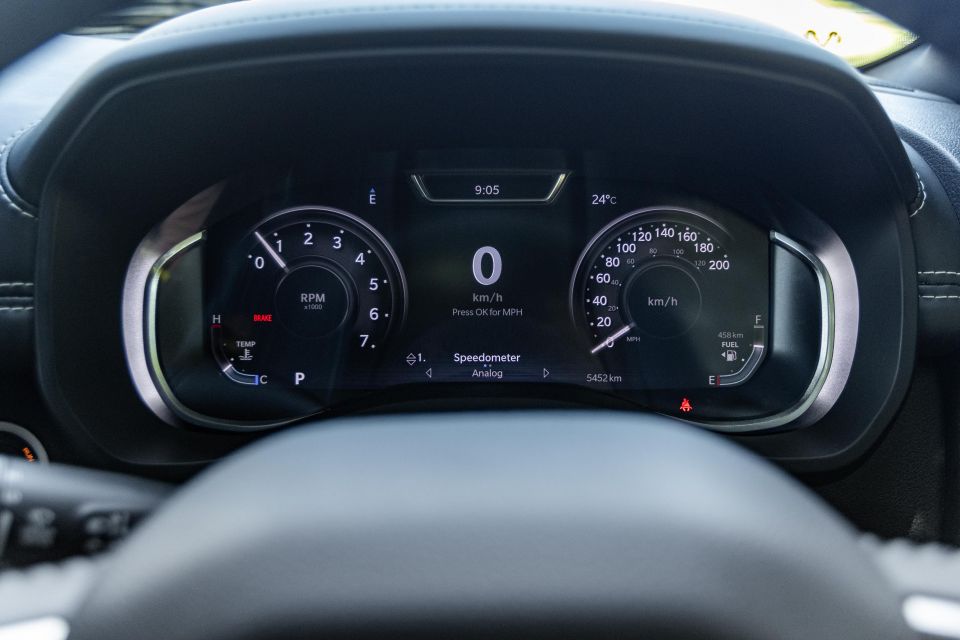


What I didn’t get used to, however, was the tiny amount of screen real estate Android Auto takes up. Despite this smartphone mirroring application having been updated to stretch across displays of all different shapes and sizes, on the Ram it only takes up a small portion towards the top of the touchscreen – even though Apple CarPlay takes up the whole screen.
At least the wireless connection was superb, with Android Auto activating seamlessly every time I started the car and never dropping out, except in one undercover parking lot. There’s no digital radio, but your beats will sound excellent piped through the 19-speaker Harman Kardon sound system.
The Uconnect 5 infotainment system works well, small smartphone mirroring display aside, with quick response times, attractive graphics, and a customisable home screen where you can add shortcuts for functions – for example, the heated and ventilated front seats.
There are shortcut buttons to the different menus always visible on screen, as well as other shortcuts to functions like the camera view.
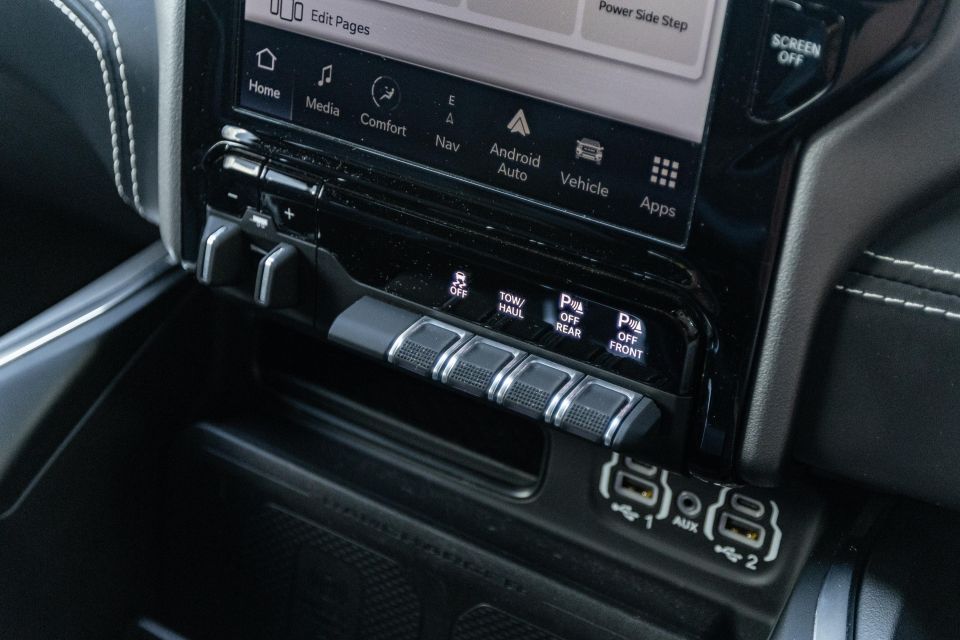
There are also helpful hard shortcut buttons surrounding the touchscreen, including redundant climate controls, a handy off switch for the LaneSense system, and actual knobs for volume and tuning.
Camera quality is decent, and the surround-view camera makes the burly Ram a breeze to park. However, the cameras only take up a small portion of the screen, much like Android Auto. You can toggle between the different camera views and even add an auxiliary camera.
As is common with North American Stellantis products, the volume and skip track buttons are located behind the steering wheel. On the front, you’ll find the controls for both regular and adaptive cruise control, as well as switches for ending a call and for navigating the neat, customisable digital instrument cluster.
Ram has also grouped the wiper and light controls on a single stalk, though it didn’t prove too bothersome.
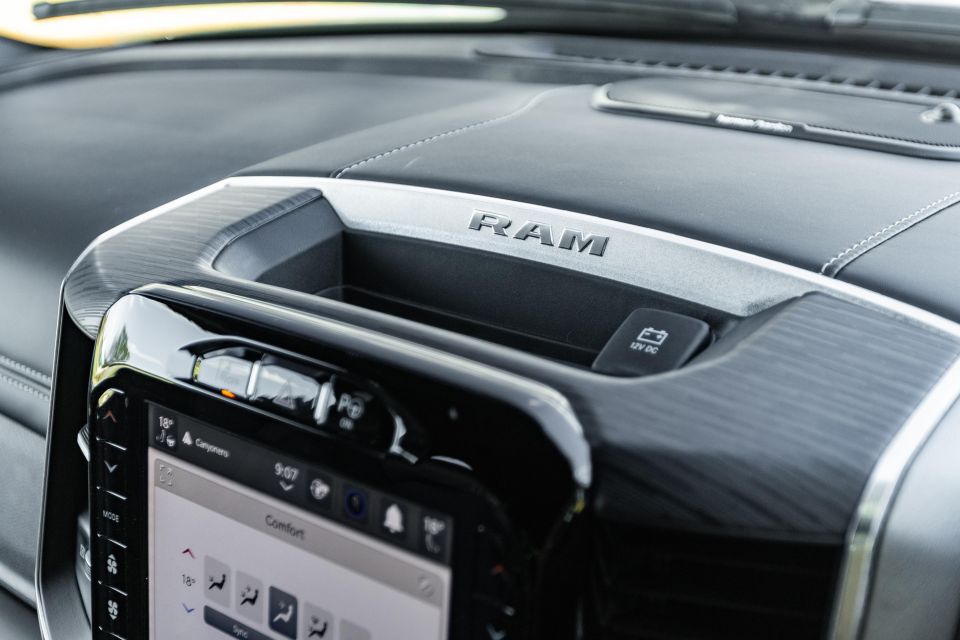

There are multiple ways to connect a device, with two USB-C and two USB-A ports up front as well as an AUX outlet. There’s also a 12V outlet atop the centre stack, next to a little rubberised nook, as well as a wireless phone charger with a rather odd design.
The front seats are extremely comfortable and are power-adjustable, heated and ventilated. The steering wheel adjusts for rake and reach, while there are power-adjustable pedals controlled via buttons to the right of the steering wheel.
There’s a heated steering wheel too, although unusually the button for it is on the passenger’s side of the touchscreen. At least the company didn’t cheap out on the footwell when remanufacturing it in right-hand drive, as there’s a proper footrest for the driver.
While some vehicles seem to lose their remote start in their transition to the Australian market, the Ram keeps it, allowing you to listen to the burble of the V8… oh, and ensure the cabin is cooled or heated before you get in.
The back seat of the Ram 1500 is positively palatial, and makes a Ranger or HiLux look cramped in comparison.

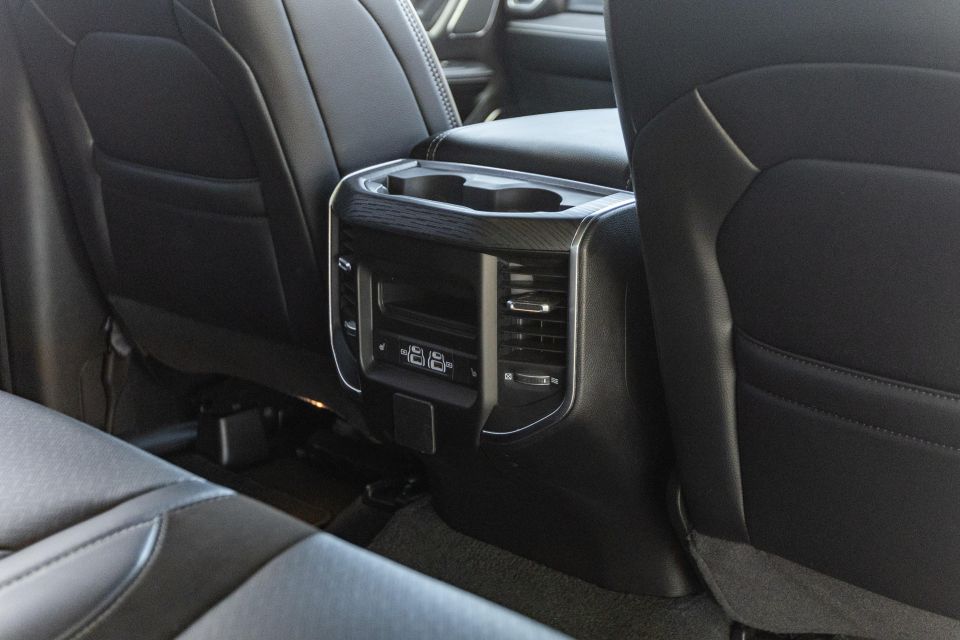
Hell, it makes almost anything look cramped. Just look at the amount of spread out room on offer here, not to mention a floor that’s almost entirely flat. You can also comfortably fit three grown adults side-by-side here, while unusually for a ute the rear seats can be reclined.
The rear doors open nice and wide, while the power running boards were perhaps the biggest surprise and delight feature my passengers encountered – besides that giant back seat, that is. These drop down whenever you go to open a door, and then retract a few seconds after it’s closed, and are a superb inclusion.
The rear seats are heated, and there’s a fold-down centre armrest with cupholders and a storage nook, plus two USB-C and two USB-A outlets and another two cupholders at the rear of the centre console. Grab handles can be found on the B-pillars.
There’s also plenty of storage back here, with compartments on each side under the floor mat. The seat bases also lift up, revealing more storage. A small portion of the rear window opens with the press of a button up front, handy if you have a dog that wants to poke its face in or out.
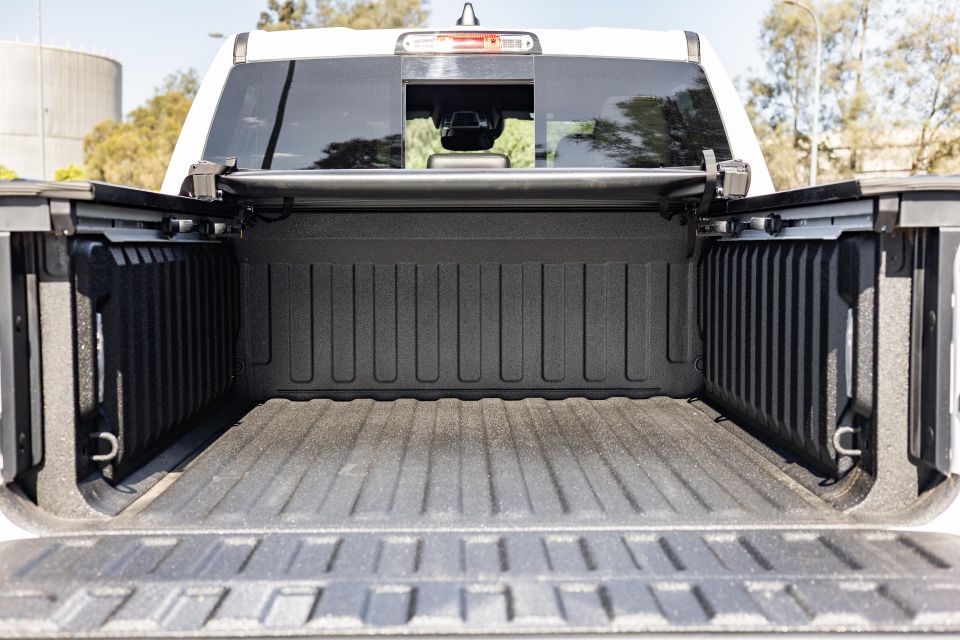
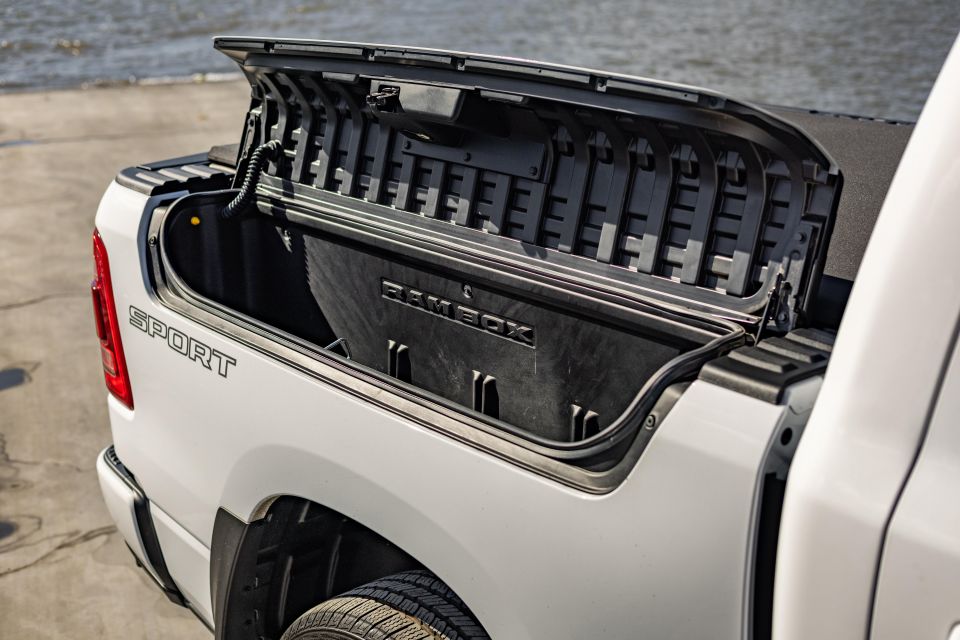
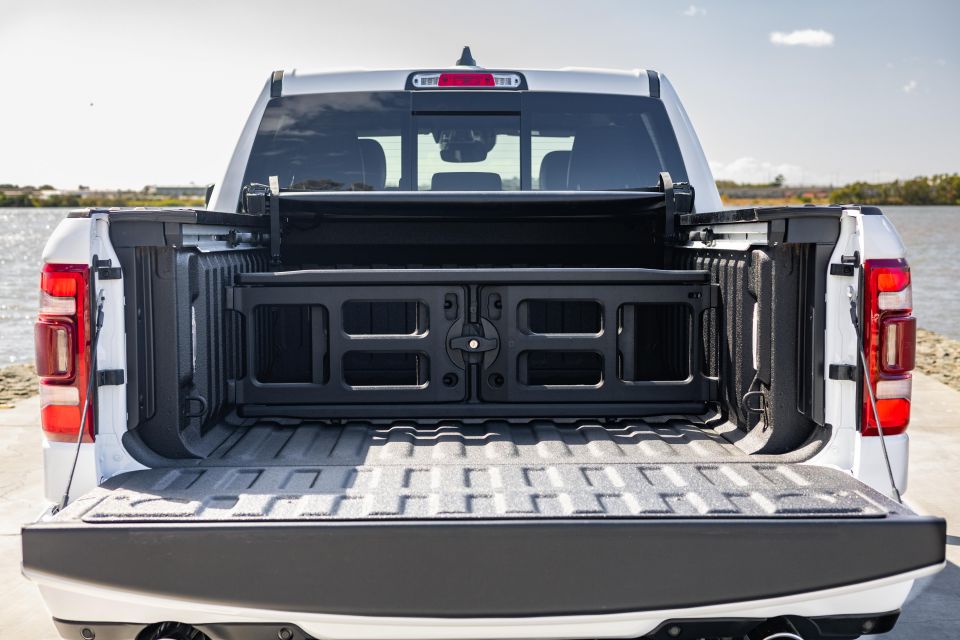
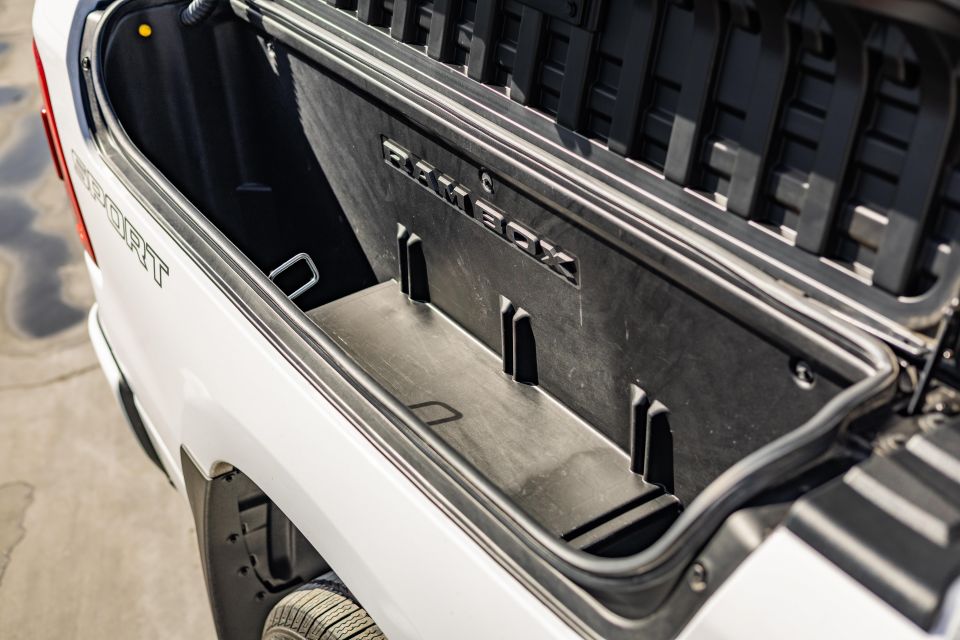
There are 210L RamBox storage compartments on either side of the tub, which are deep, lockable and drainable. Drop the tailgate, which you can do with two presses of the key fob, and you’ll see a plastic gate. This can be moved to slot into any groove within the tub, which is handy if you want to separate your load.
The tonneau is quite rigid, but simply pull and twist the stalks on either side and it’ll pop up, allowing you to fold it a few times to expose the load bay.
The tub itself measures 1712mm long, 1270mm wide and 543mm deep, with 1.5m3 of volume. For reference, a Toyota HiLux’s tub is 1570mm long, 1645mm wide (1109mm between the arches) and 481mm deep.
The DT-series Ram 1500 – supercharged V8-powered TRX aside – is offered exclusively with a5.7-litrenaturally aspirated petrol V8 producing 291kW of power and 556Nm of torque.
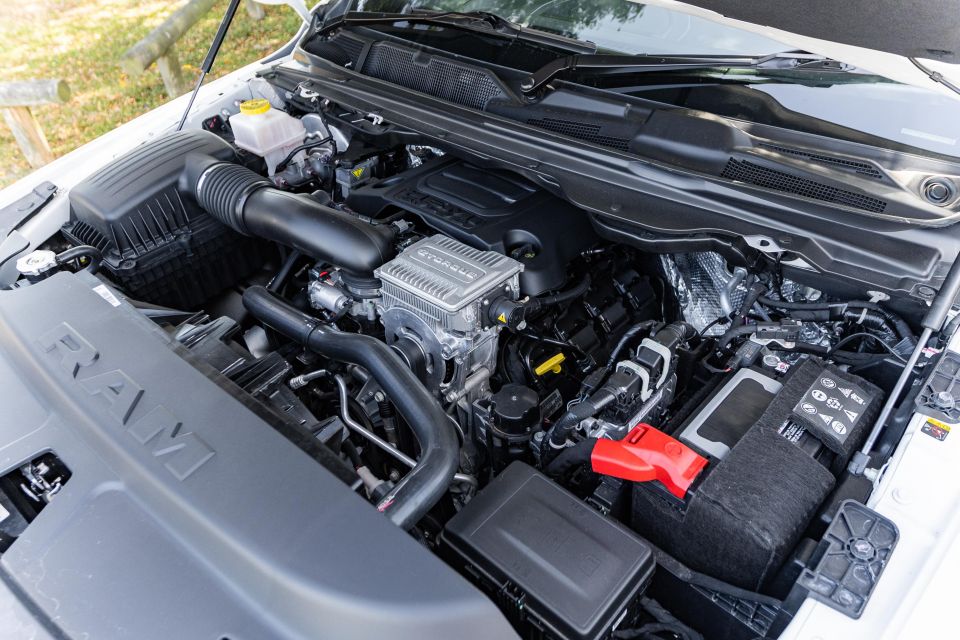
It’s mated with an eight-speed automatic transmission and a full-time four-wheel drive system, and is augmented by a 48V mild-hybrid system.
In 0-100km/h testing, we recorded a time of 7.0 seconds, which is pretty quick for something this big (5916mm long) and heavy (2553kg tare). It also stops in short order, with a 100-0 time of 2.95 seconds and a stopping distance of 41.32m.
The Ram 1500 can be driven in rear-wheel drive, or you can select 4WD Auto – which can safely be used on all surfaces – or 4WD Low and 4WD High modes intended for off-roading.
Over a mix of inner-city, suburban and highway driving, we averaged 13.8 litres per 100km. That was actually 0.2L/100km better than a V6-powered Jeep Gladiator over the same loop, although it’s around 4L/100km higher than we’d typically see in a four-cylinder turbo-diesel Thai ute.
Over the course of a week, this increased to 15.3L/100km. The official combined cycle claim is 12.2L/100km. The 1500 has a 98L fuel tank and 98RON premium unleaded fuel is recommended.
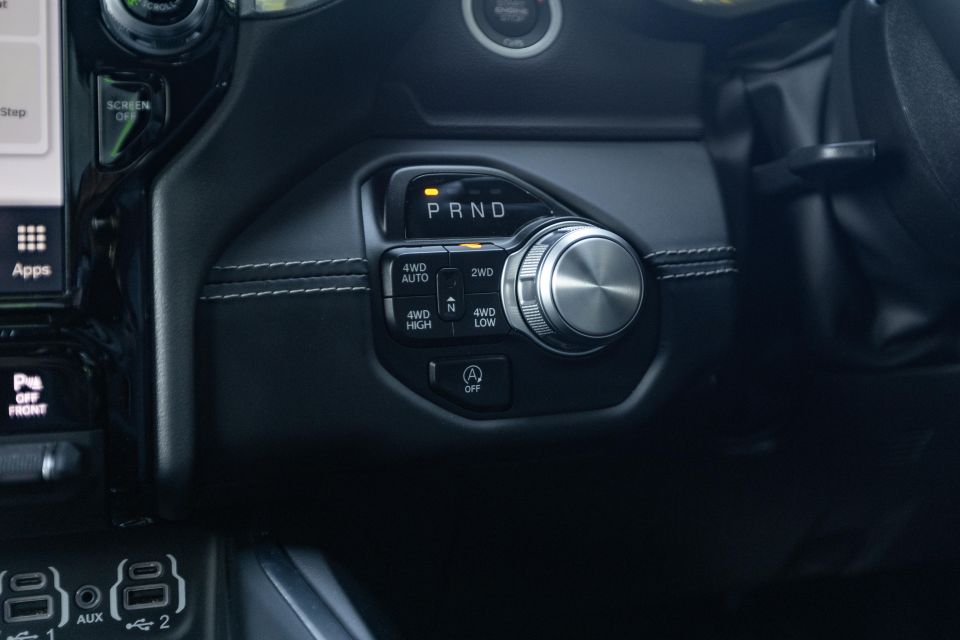
Braked towing capacity is 4500kg, which beats even the most capable Thai-built ute by a tonne.
You may be surprised at the Ram’s payload figure, which is the maximum amount of weight the manufacturer says the vehicle can carry.
It’s just 897kg, or 79kg less than a range-topping Ford Ranger Platinum. Add a whole family, and that figure is going to shrink markedly. It’s better than an F-150 Lariat SWB (685kg) or Silverado LTZ (757kg), however.
If I may use a very American analogy, driving a Ram 1500 for the first time is like handling and firing an M16 for the first time. You know it’s a capable weapon, but you expect it to be unruly and hard to handle.
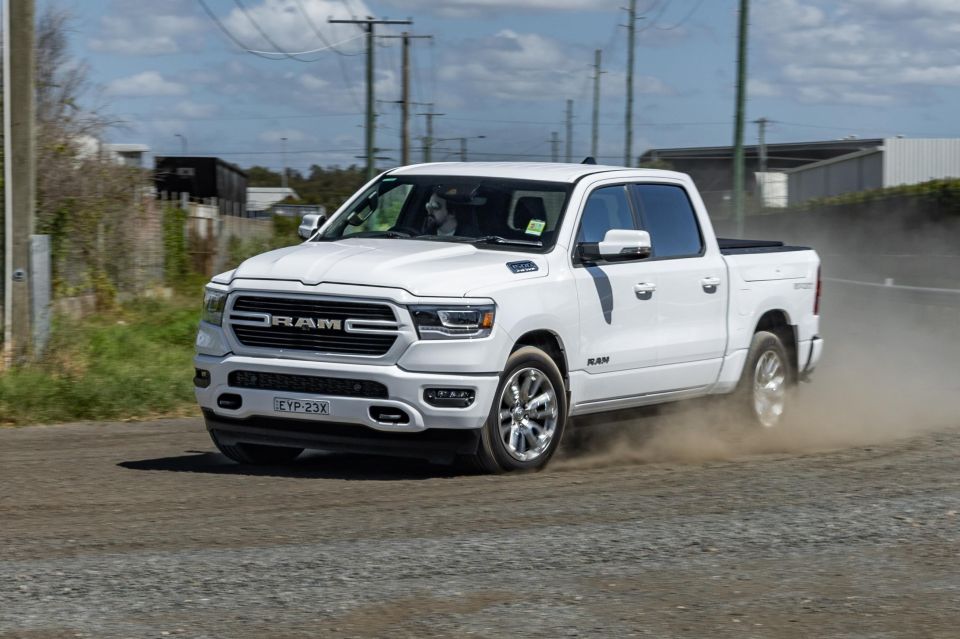
What you find, however, is an M16 is effortless to shoot with, with even less recoil than a handgun, while a Ram 1500 is so much easier to manage than its outsized dimensions would suggest.
Within a few minutes of driving the Ram 1500, I had become comfortable. The steering is a little vague on centre, but it strikes a good balance in terms of weighting.
The various cameras, blind-spot sensors and large exterior mirrors make it easy to place within a lane or back into a spot, and overall it feels scarcely larger or more cumbersome than a HiLux or Ranger to drive.
Sure, you may find yourself avoiding certain cramped parking lots, but ultimately I had no problem finding parking spaces that fit the Ram.
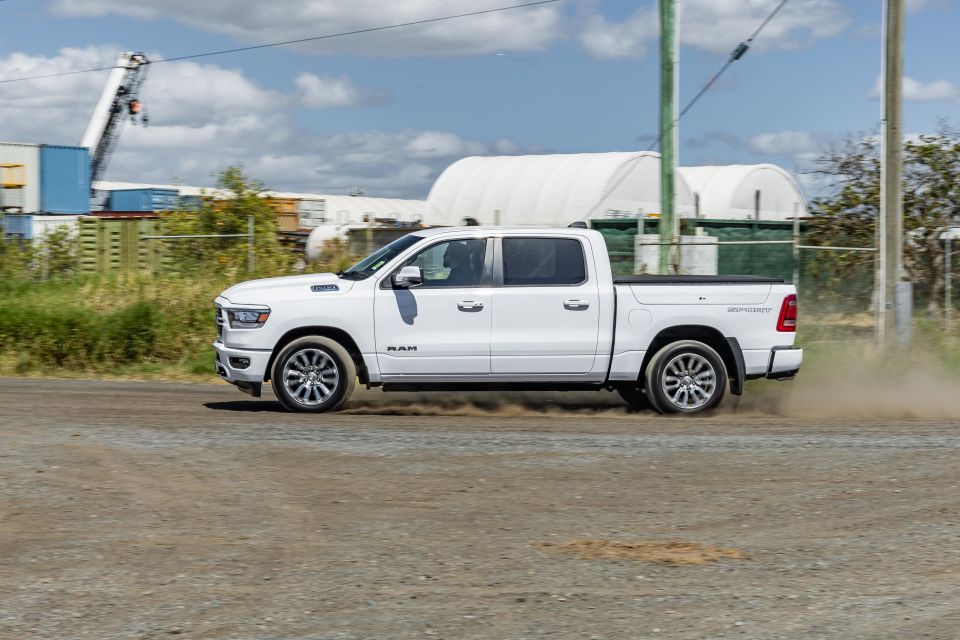
Where expert car reviews meet expert car buying – CarExpert gives you trusted advice, personalised service and real savings on your next new car.
The most impressive part of the Ram 1500 driving experience is its refinement. The V8 sounds lovely when you plant your foot, but for the most part it just disappears into the background.
Even at highway speeds or coarser chip roads, road noise doesn’t intrude into the cabin – even the large exterior mirrors don’t result in excessive wind noise.
Then there’s the ride quality, which is simply superb for a ute and quite impressive for any vehicle. It glides over pockmarked roads, even with just one person on board and nothing in the tray.
It’s rather surprising for a body-on-frame vehicle, with no shaking or quivering through the structure. The Ram also avoids feeling too floaty and ponderous, though Paul Maric did note body control got a bit sloppy going across sine waves at our testing grounds at 130km/h due to the soft suspension tune.
The fancier Limited may offer air suspension, but it scarcely seems necessary. Only when you hit multiple successive ruts or crags do you even really feel anything, and the 1500 still largely shakes these off like it’s no problem.
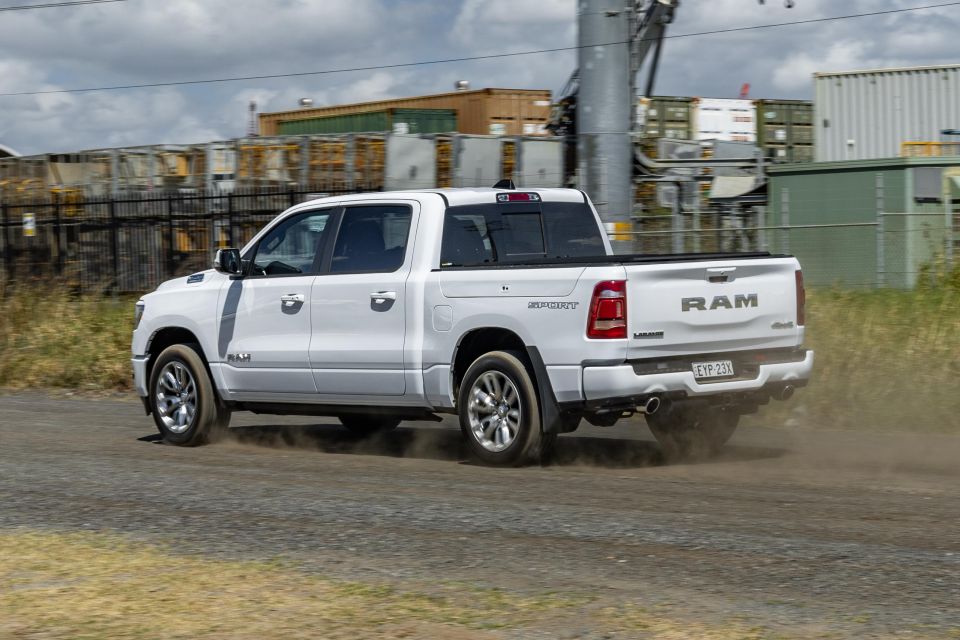
A couple of elements do detract from the picture of refinement. There’s an audible clunk from the transmission or mild-hybrid system as you slow to a halt, and at low speeds if you let off the accelerator you’ll also feel a shunt. It’s odd, as the actual operation of the automatic stop/start system is smooth.
The 1500 also suffered from intermittent steering rack rattle, occasionally sounding like a marble was loose somewhere in the steering column. At low speeds, for example while navigating a parking lot, the Ram’s steering also squeaks incessantly.
I propose the rumoured inline six-cylinder replacement for the Hemi V8 will probably get better real-life fuel economy, not just because of its greater efficiency but because it surely won’t sound as good as this – making a cheeky mash of the accelerator less tantalising.
Nevertheless, despite a big, thirsty V8 under the bonnet, the Ram managed decent fuel economy for something this size, weighing this much. In addition to making lovely noises, the V8 is also responsive, while the transmission shifts smoothly and unobtrusively. There’s no sport mode to quicken shifts, but that wouldn’t suit the Ram’s unruffled demeanour anyway.
There are also no paddle shifters here, not that you’d really need them, although there are steering wheel controls that allow you to change the maximum gear you’re in, allowing it to shift between lower gears on its own but stopping it from exceeding a particular gear.
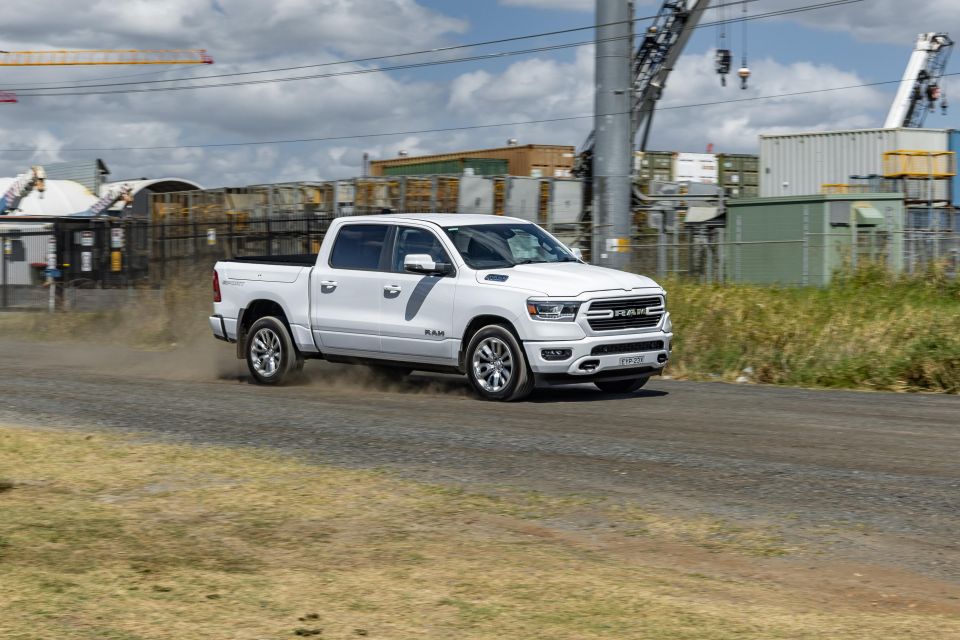
The LED headlights are bright, and there are handy cornering lights that activate when you turn the steering wheel in a particular direction. There’s also automatic high-beam, which you can activate by knocking the stalk away from you.
There’s adaptive cruise control, but we found it wouldn’t keep to the set speed while heading downhill. The LaneSense system operates between 60 and 180km/h, and its sensitivity can be adjusted but we found it to be unobtrusive. Nevertheless, you can turn it off with the press of a button and it’ll default to off.
I quickly turned off the navigation alert sound that warns you of things like speed cameras, which is simply too loud. I was also alerted to the presence of a reverse AEB function when it decided to alert me to the presence of a tree as I was backing into a space. I wasn’t going to hit it – I have eyes, after all – but I still think this is a handy safety feature to have.
The Laramie Sport has a rear limited-slip differential but no locking rear differential or hill descent control. Despite this, it lapped up our off-road course with no problems, though we wonder how many owners will actually take theirs off the beaten track. Approach and departure angles are both 20.4 degrees, and there’s 226mm of ground clearance.
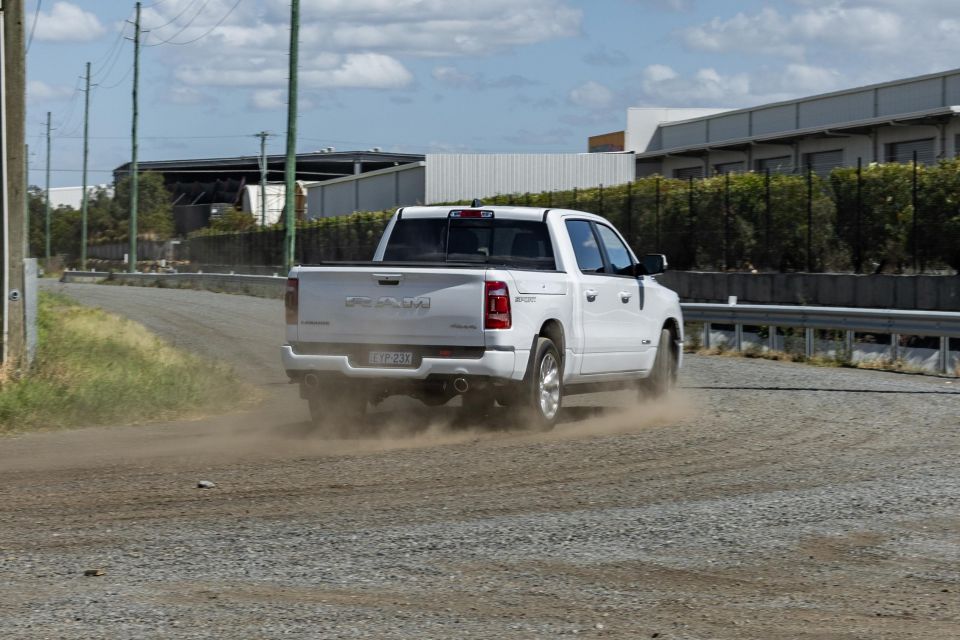
We suspect more owners will use the Ram to tow, and we tested a regular Laramie as part of our Ute of the Year competition and found it to be a superb towing vehicle with a controlled ride and ample performance.
Even with a trailer attached with 3kN of resistance force, simulating a fairly steep ascent, our Laramie tester could still hit 100km/h in 11.5 seconds. Like the Laramie, the Laramie Sport features an integrated trailer brake controller.
It’s rare that I would say this about a ute, but if I wanted to do a cross-country road trip in a vehicle, the 1500 would be towards the top of my list. Well, if somebody else was paying for fuel.
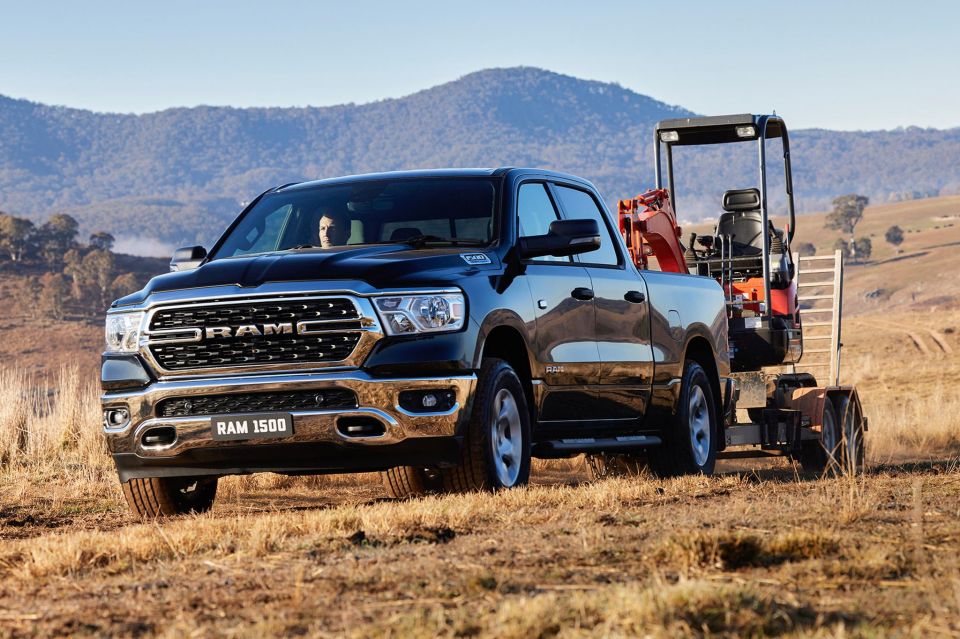
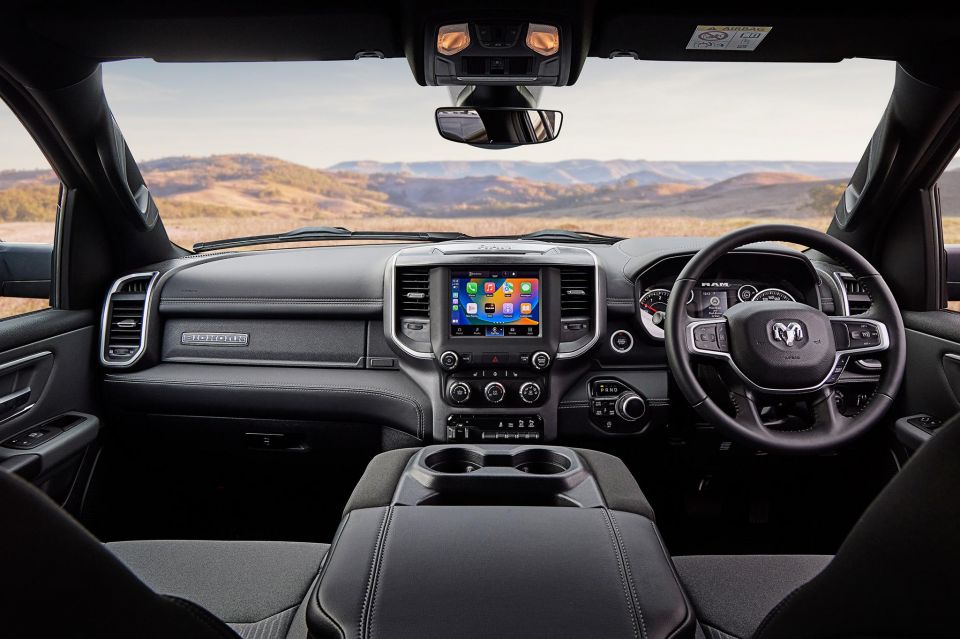
Ram 1500 Big Horn highlights:

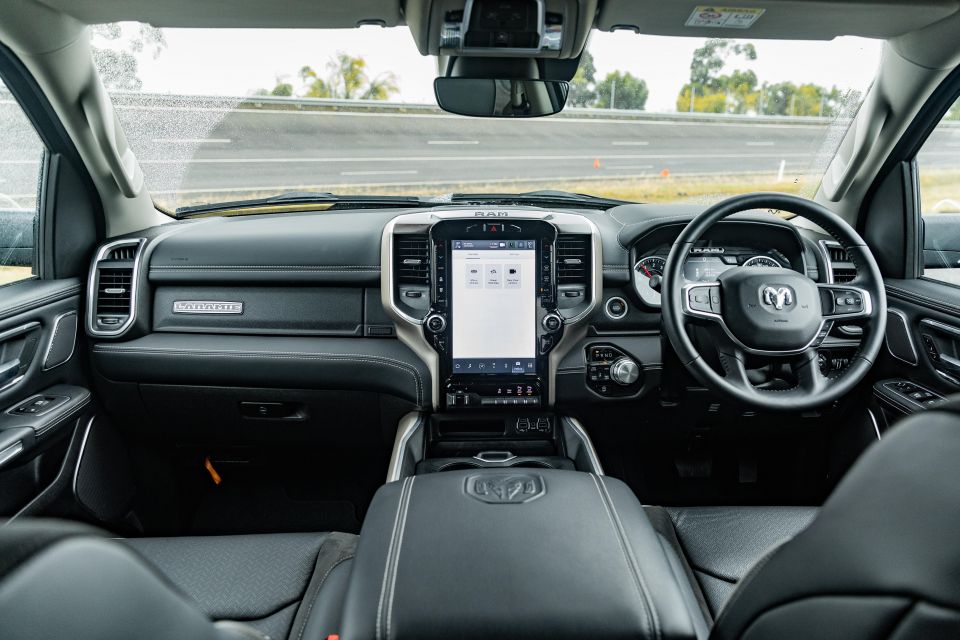
Ram 1500 Laramie adds:
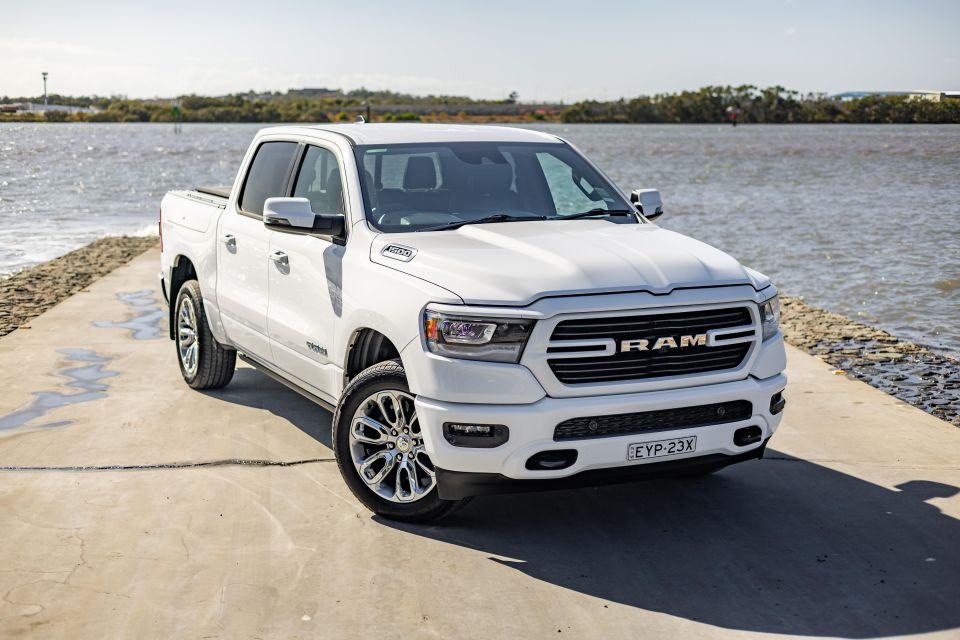

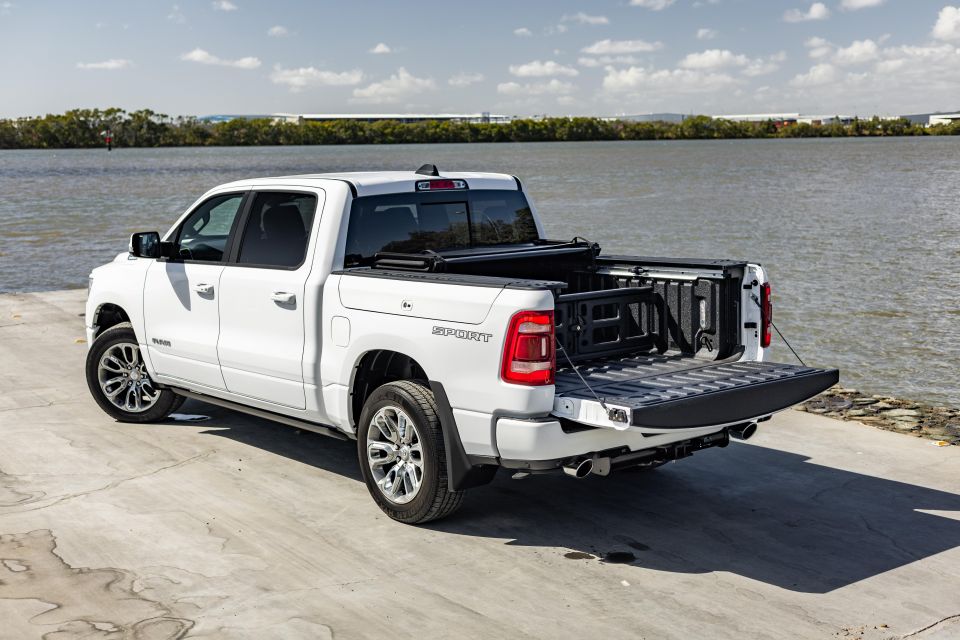

Ram 1500 Laramie Sport adds:
It also includes various additional safety features, detailed below. While that’s an extensive features list, you can still step up to the Limited which brings additional niceties like a panoramic sunroof, 22-inch alloy wheels, air suspension, and ventilated rear outboard seats.
The Ram 1500, like its rivals, has never been tested by ANCAP.

All DT-series 1500s come with autonomous emergency braking (AEB), front and rear parking sensors, a reversing camera, and front, front-side and curtain airbags.
Laramie Sport adds:
Ram offers only a three-year, 100,000km warranty with an identical period of 24/7 roadside assist, and has no capped-price servicing scheme. That’s so last decade.
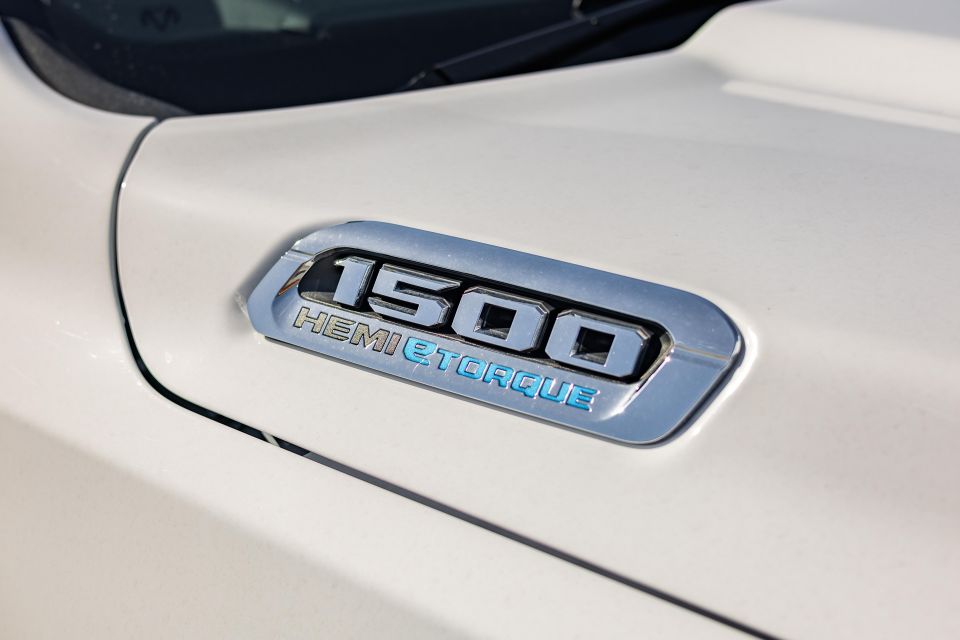
In fairness, the Chevrolet Silverado has the same coverage. But Ford has come in and shaded them both, with a five-year, unlimited-kilometre warranty on the F-150 and four years of capped-price servicing, with each visit costing $429.
It remains to be seen whether Ram will up its game in this respect. Servicing intervals are every 12 months or 12,000km – whichever comes first.
Let’s just get this out of the way: if you live in Newtown or New Farm, the Ram 1500 probably isn’t for you.
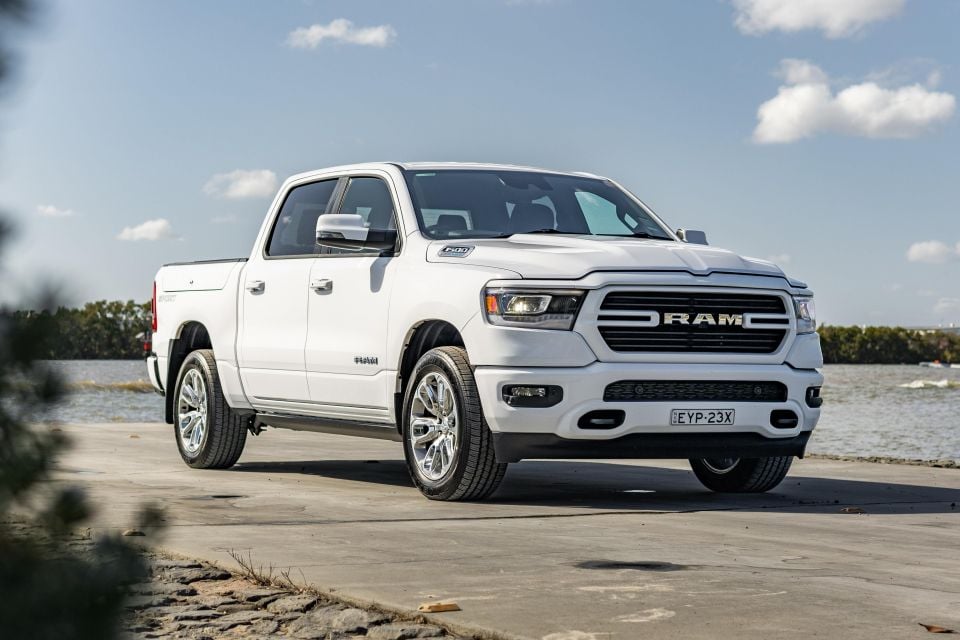
It’s big, and despite the surround-view cameras, parking aids and comfortable steering, there’s no escaping basic physics.
For all those living in suburban or regional Australia, the 1500 makes a lot more sense. It’s extremely comfortable, whether you’re tootling around town, cruising down a dirt road, or towing a heavy load.
The cabin is richly appointed, sumptuously comfortable and spacious, and full of clever storage solutions. The technology is thoroughly modern and works well, too.
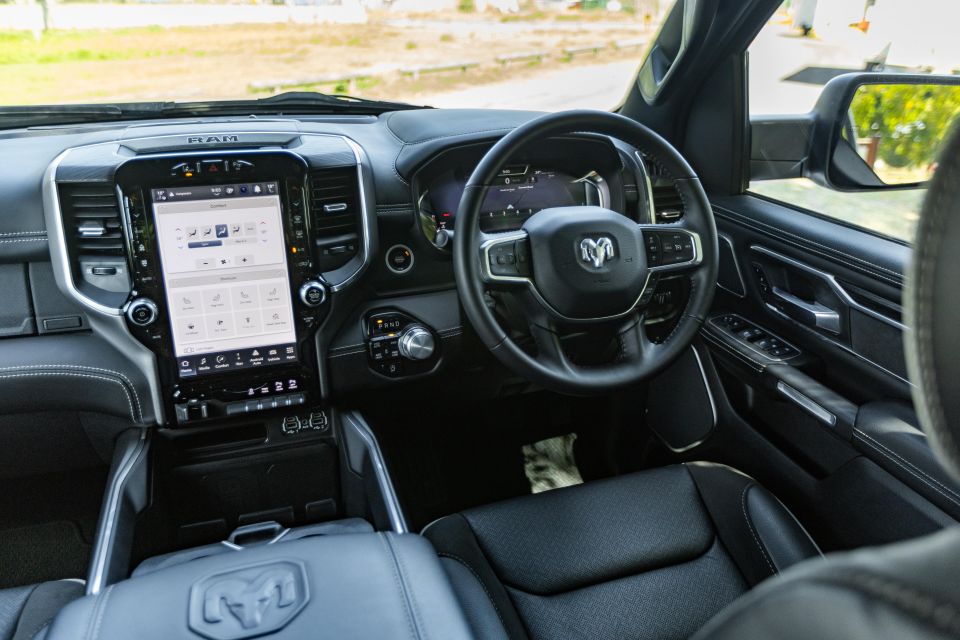
The remanufacturing process has also resulted in little in the way of idiosyncrasies. We’re not sure if the steering rattles and squeaks are unique to our local conversion, but otherwise the truck looks and feels like it was originally built in right-hand drive apart from a bumper-mounted reversing light.
The Laramie Sport is the sweet spot in the range, eschewing some of the luxury gee-gaws of the Limited but offering the key safety equipment the lesser Laramie really should have at its price. It’s worth the premium.
The competition is fiercer than ever, with an updated Silverado out now, the F-150 reaching showrooms, and the Tundra expected in 2024. This Australian-market pioneer, however, still stands strong.
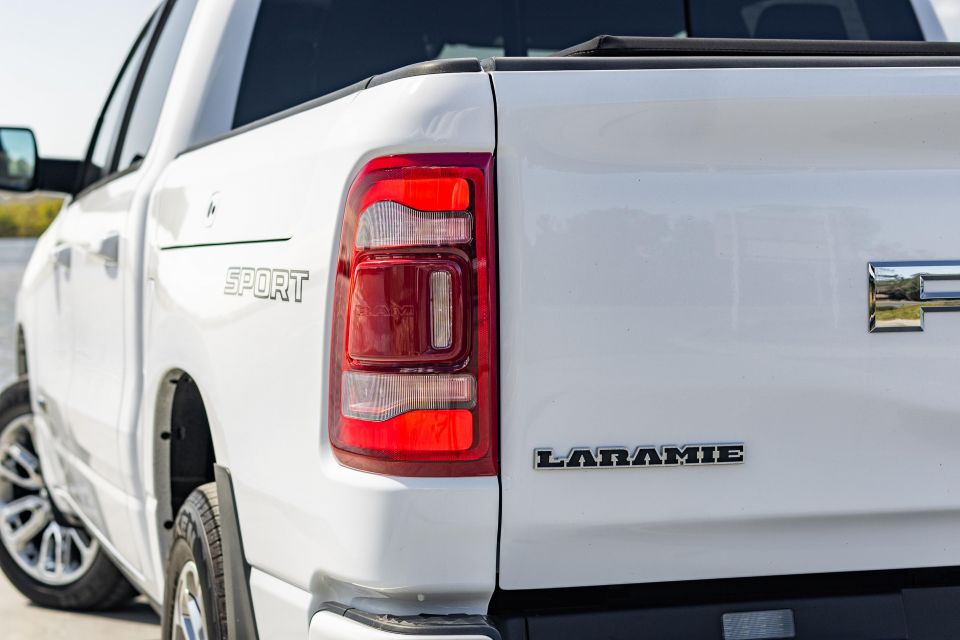
Click the images for the full gallery
MORE: Everything Ram 1500
Where expert car reviews meet expert car buying – CarExpert gives you trusted advice, personalised service and real savings on your next new car.
William Stopford is an automotive journalist with a passion for mainstream cars, automotive history and overseas auto markets.


Damion Smy
13 Hours Ago


Damion Smy
16 Hours Ago


Ben Zachariah
3 Days Ago


Matt Campbell
3 Days Ago


Derek Fung
7 Days Ago


Damion Smy
10 Days Ago